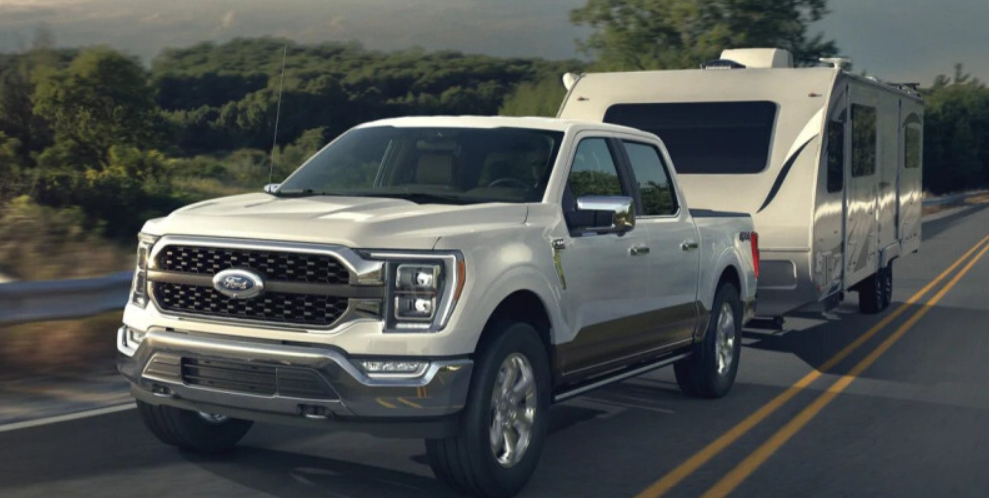Every vehicle comes with a designated towing capacity, and this isn’t just a recommendation; it’s an imperative guideline to ensure safety, vehicle longevity, and optimal performance. Knowing the specific towing capacity of your vehicle allows you to operate within its limits, ensuring the safety of you, your vehicle, and other road users. For F150 owners, determining the exact ford f150 towing capacity by VIN can be particularly beneficial.

VIN: A Key to Unraveling the Mystery
The Vehicle Identification Number (VIN) isn’t just a random series of numbers and letters. It’s a specific code that contains critical information about your vehicle, including its towing capacity. By decoding the VIN, you can unlock the true potential of your F150 and tow confidently.
Understanding the Vehicle Identification Number (VIN)
Every vehicle possesses a unique VIN, which serves as its fingerprint. It’s a 17-character identifier that holds critical information about your vehicle’s specifications and features.
What is a VIN and Why is it Important?
A VIN provides details on where the vehicle was manufactured, its type, engine size, series, and more. For authorities and service providers, the VIN helps in tracking recalls, registrations, warranty claims, and thefts. For the average owner, it can be the key to understanding specific features, including the ford f150 towing capacity by VIN.
Breaking Down the Components of a VIN
The VIN’s 17 characters are divided into sections. The first character identifies the country where the vehicle was manufactured, while the next two give information about the manufacturer. The next five characters typically describe the vehicle’s attributes, such as body type and engine size. The remaining characters can include a security check digit, model year, assembly plant, and the vehicle’s serial number.
The Ford F150: America’s Best-selling Pickup
From its inception, the Ford F150 has been a symbol of strength, reliability, and versatility in America.
Brief History and Legacy of the F150
Since its introduction in 1948, the F150 has undergone numerous transformations, each time adapting to the needs of its time, yet consistently delivering top-notch performance. Its durability and adaptability have cemented its place as America’s best-selling pickup for over four decades.
F150’s Versatility: From Everyday Use to Heavy Lifting
Whether it’s for daily commuting, off-road adventures, or heavy-duty work, the F150 has proven its mettle. And while many use it for routine drives, its towing prowess, especially the ford f150 towing capacity by VIN, is one of its standout features.
Why Towing Capacity Matters
The Dangers of Overloading Your Truck
Exceeding your vehicle’s towing capacity can lead to various problems, from reduced brake efficiency and tire blowouts to potential transmission damage. Overloading also affects the vehicle’s stability, making it more susceptible to swaying or even rolling over.
Legal Implications and Compliance
Apart from safety concerns, towing beyond your vehicle’s capacity can lead to legal implications. Depending on the jurisdiction, overloading can result in hefty fines, invalidated insurances, or even impounded vehicles.
Determining the F150’s Towing Capacity Using VIN
For many F150 owners, determining the exact towing capacity can be a challenge. However, using the VIN can simplify this.
Where to Find Your F150’s VIN
Typically, the VIN is located on the driver’s side dashboard, visible through the windshield. It can also be found on the vehicle’s registration documents, title, and insurance papers.
Steps to Decode Towing Capacity from the VIN
- Locate the VIN on your F150.
- Use a VIN decoder tool, readily available online.
- Enter the VIN and review the detailed specifications, looking specifically for the towing capacity.
- For more detailed or model-specific data, consider contacting a Ford dealer with your VIN.
Factors Influencing the F150’s Towing Capacity
Engine Size and Type
The engine plays a pivotal role in determining towing capacity. Larger engines, often V8s, will typically tow more than their V6 counterparts. Similarly, diesel engines might offer more torque, which can influence the ford f150 towing capacity by VIN.
Drivetrain and Transmission Options
Four-wheel-drive (4WD) systems might offer more towing capacity than two-wheel-drive (2WD) models due to increased traction. Transmission types, whether manual or automatic, also play a role in towing limits.
Suspension and Brake Systems
A robust suspension system is essential for stability when towing heavy loads. Similarly, efficient braking systems ensure safety when the vehicle is loaded to its maximum capacity.
By understanding and respecting the ford f150 towing capacity by VIN, F150 owners can ensure safety, longevity, and optimal performance for their beloved trucks.

Variances in Towing Capacity Over the Years
The F150, over its storied history, has seen numerous changes in design, powertrain, and technology. This, in turn, has led to variances in its towing capacity. By examining the ford f150 towing capacity by VIN across different models, one can chart the evolutionary path of this iconic truck in terms of its hauling prowess.
Evolution of the F150’s Towing Abilities
From its earlier iterations in the late 20th century to the technologically advanced models of today, the F150’s towing capacity has seen a steady increase. In the 1980s, the F150 was equipped to tow roughly 5,000 to 6,000 pounds. By the early 2000s, advancements in engine and chassis design pushed this limit to nearly 8,000 pounds. Fast forward to recent years, and some F150 models, when appropriately equipped, boast a towing capacity upwards of 13,000 pounds.
Deciphering the ford f150 towing capacity by VIN allows owners to pinpoint the exact towing specifications for their particular model and year, making it easier to understand the evolutionary steps in between.
Notable Milestones and Innovations
Several milestones mark the F150’s journey. The introduction of the EcoBoost engine in the 2010s significantly increased torque, thus enhancing towing capacity. Additionally, Ford’s move towards a high-strength, military-grade aluminum alloy body in recent models reduced the truck’s weight, allowing for increased payload and towing capacities.
Further, innovations such as dynamic hitch assist and trailer brake control systems integrated into modern F150s provide drivers with more confidence and control when towing, reflecting Ford’s commitment to combining power with safety.
Practical Implications of Towing Capacity
Understanding the ford f150 towing capacity by VIN isn’t just about knowing the maximum weight your truck can pull. It has real-world implications for safety, vehicle longevity, and performance.
Choosing the Right Trailer or Load
Having clarity on your F150’s towing capacity ensures that you choose a trailer or load that’s within its limits. This is crucial, not just for safety but also to prevent undue strain on the vehicle’s engine, transmission, and brakes. For instance, if your VIN indicates a towing capacity of 10,000 pounds, towing something weighing 9,500 pounds provides a safe margin without approaching the absolute limit.
Ensuring Safe Towing Practices
Beyond just weight limits, knowing your truck’s towing capacity assists in practicing safe towing. This includes ensuring that the weight is evenly distributed in the trailer, understanding the need for sway controls, or realizing the significance of regular maintenance checks when frequently towing heavy loads.
Accessories and Tools to Enhance Towing
The right accessories can significantly enhance your towing experience, providing added safety and convenience. When considering the ford f150 towing capacity by VIN, it’s equally essential to consider these tools and upgrades.
Essential Towing Accessories for Your F150
- Towing Mirrors: These extendable mirrors provide a wider field of view, ensuring you can see the entire length of your trailer or load.
- Weight Distribution Systems: These systems help in evenly distributing the trailer’s weight, enhancing stability, and reducing swaying.
- Trailer Brake Controllers: An essential tool for heavy towing, it ensures synchronized braking between the truck and the trailer.
- Hitch Receivers and Ball Mounts: Depending on the type of trailer and the weight, selecting the right hitch receiver and ball mount is crucial for safe towing.
Upgrades to Optimize Towing Performance
- Upgraded Suspension: Enhancing the suspension can provide better stability, especially when towing at or near the truck’s maximum capacity.
- Improved Cooling Systems: Towing can strain the engine. An upgraded cooling system ensures it doesn’t overheat during heavy-duty hauling.
- Performance Tuners: These devices can adjust parameters in the truck’s computer, optimizing performance when towing.
By understanding the intricate details embedded in the ford f150 towing capacity by VIN, F150 owners can maximize the potential of their truck, ensuring safe, efficient, and effective towing for years to come.
Tips and Tricks for Towing with the F150
Towing can be a challenging task, even for seasoned drivers. With the Ford F150’s impressive capabilities, it’s paramount to know some of the best practices. Here’s a closer look at some tips and tricks for leveraging the ford f150 towing capacity by VIN to its fullest potential.
Pre-trip Checklist for Safe Towing
- Vehicle Inspection: Always start by checking the basic health of your F150—oil levels, brake fluids, tire pressure, and headlights.
- Trailer Inspection: Check the trailer’s tire pressure, ensure all lights are functioning, and double-check the connection to the hitch.
- Weight Distribution: Ensure that the trailer’s weight is evenly distributed, with roughly 60% of the weight over the front half of the trailer.
- Brake Testing: Before heading out, test the brakes at a low speed to ensure they’re in sync between the F150 and the trailer.
- Secure the Load: Ensure that whatever you’re towing is securely fastened, reducing the risk of any accidental offloading.

Maintaining Your F150 for Long-term Towing Usage
- Regular Oil Changes: Towing can put added strain on your engine. Regular oil changes ensure it operates efficiently.
- Transmission Fluid Check: For those who frequently maximize the ford f150 towing capacity by VIN, keep an eye on the transmission fluid, ensuring it’s at the optimal level and condition.
- Brake Maintenance: Due to the added weight when towing, brakes might wear down faster. Regularly inspect them for wear and tear.
- Tire Check-ups: Towing can lead to quicker tire wear. Regular rotations and balance checks can extend their life.
F150 Owner Stories: Real-world Towing Experiences
Hearing from F150 owners gives fresh perspectives on the practical aspects of towing.
Challenges Encountered and Overcome
- Tom’s Steep Hill Dilemma: Tom, an F150 owner, once shared his experience of towing a heavy RV through hilly terrains. Using the ford f150 towing capacity by VIN as a guide, he had to maneuver strategically to prevent strain on the engine.
- Sarah’s Cross-country Move: Sarah used her F150 to move cross-country. By correctly calculating her ford f150 towing capacity by VIN, she managed to make the journey without overloading her trailer, ensuring safe transit of her belongings.
Insights and Lessons Learned from F150 Enthusiasts
- Understand Before You Tow: Many owners emphasize the importance of knowing the ford f150 towing capacity by VIN before attempting to tow.
- Practice Makes Perfect: Regular practice in a controlled environment, like an empty parking lot, can make towing in real-world situations more manageable.
Conclusion
Ford F150 stands as a testament to engineering marvel and practicality. Its diverse towing capabilities, accessible through decoding the ford f150 towing capacity by VIN, offer users a unique blend of power and safety.
By understanding the ins and outs of your F150, embracing safety protocols, and ensuring regular maintenance, F150 owners can enjoy a long-lasting and efficient towing experience.
FAQs
Can I trust online VIN decoders for accurate towing capacity?
While many online VIN decoders provide accurate information, it’s always best to cross-reference with official Ford sources or your vehicle’s manual for the most precise ford f150 towing capacity by VIN.
Does modifying my F150 affect its official towing capacity?
Yes, modifications can impact towing capacity. Upgrades might enhance it, while certain additions might reduce it. Always consult with professionals before making significant changes.
Is there a difference in towing capacity between F150 models of the same year?
Absolutely. Differences in engine size, drivetrain, and other factors mean that towing capacity can vary even among F150s of the same year. Always refer to the ford f150 towing capacity by VIN for precise details.
How often should I service my F150 if I frequently tow near its max capacity?
If you regularly tow heavy loads, consider more frequent service intervals—perhaps every 3,000-5,000 miles. Regular checks ensure the longevity of your vehicle.
What other essential vehicle specs can I determine using my F150’s VIN?
A VIN can provide details about the vehicle’s manufacturer, engine size, series, model year, assembly plant, and more. While it’s a treasure trove of information, always refer to the official sources for detailed specifications.